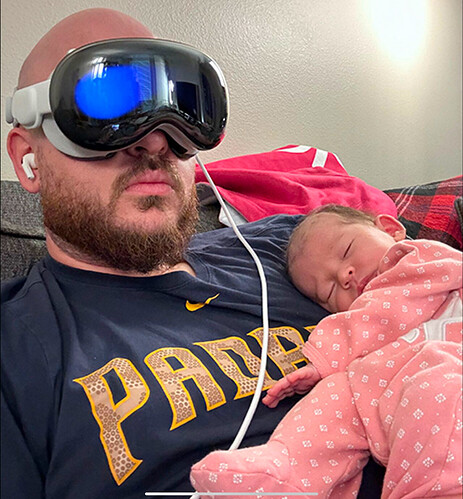How will that work given that when you buy it from Apple it is customized by size?
Or a hack. Personas were likely the only workaround they could think of for an inherently isolating device.
Which is why I think of AVP as more Virtual Reality than Augmented Reality. Still a long way to go before more useful and acceptable augmented reality tools are achieved.
![]() I had not thought about that. I don’t know unless one can take it to the store and have it fitted and the prescription adjusted.
I had not thought about that. I don’t know unless one can take it to the store and have it fitted and the prescription adjusted.
I think of it like a preview of something great, but I don’t know what the “final version” would look like. Definitely not Google Glass.
IMO it wouldn’t be anything resembling a normal pair of glasses. I don’t see people constantly wearing anything that would allow them to work on spreadsheets, etc. The AVP is around 2 lbs (with battery). I doubt if Apple can get that down to 50 grams or so any time soon. But I wouldn’t be surprised if they had a pair of smart glasses in the lab.
That’s what several other companies are working on.
OK, for some reason now I’m picturing Geordi LaForge’s visor from Star Trek ![]()
Edit: It’s weird - before the AVP was announced, I had no idea what a pair of “AR Goggles” were supposed to be, or how they would work. But now that the first version is so well described it’s really quite easy to fantasize about future iterations.
I guess this is why Apples role as innovators is so hard to emulate for other companies.
And yes, I know there were other AR/VR glasses/goggles before the AVP, but I never even wanted those, because they were basically just for gaming.
AR glasses were introduced at the end of the (rather gruesome) novel Daemon and continued to be developed in the sequel Freedom. You might also find something interesting in this list Augmented Reality Reading List (29 books) | Goodreads.
I think we are destined to always be on opposite sides of this. While I think the pictures look silly, I chalk that up to me not being used to seeing this kind of thing in public yet.
Would I personally be interested in wearing AVP at a sporting event? Nope, definitely not in their current form. But could there be utility in it as features get built out? Sure. If pass-through gets better and it becomes easier to see peoples’ eyes, I could see it. But not in the current form, especially if I’m with others. I can’t tell from that picture if he’s with friends or not. If he’s there by himself, what is the big concern? But even if it’s with friends/family and they don’t mind, what’s the concern? My guess is a lot of these in-public pictures are for attention/fun anyway.
One with the baby, I see no issues whatsoever. I have so many friends with children who are up with their kiddo in the middle of the night and he/she falls asleep on them and they then will listen to podcasts, watch movies, read things on their phone. That picture is no different to me than him watching TV while his kid sleeps.
The last picture, it’s clearly someone playing with their new toy. It’s sitting in the box he bought it in for goodness sake.
So much hand wringing.
My guess is a lot of these in-public pictures are for attention/fun anyway.
I agree. I suppose one could view this as hand ringing, though I don’t. I think it is a legitimate concern. There are ample studies, as well as anecdotal evidence, highlighting the adverse effects of too much screen time to the detriment of one’s personal, social, and mental health, as well as a detriment to general social well-being in our societies. All that I, and I believe others, are suggesting is that strapping a VR device to one’s head is likely to exasperate these problems. I am not suggesting that spatial computing doesn’t have tremendous potential. I believe it does, and I look forward to the day I can take advantage of it. My concern is not spatial computing but the notion of wearing a headset of that nature in public and with family and close friends. While one could argue a few benefits, I am suggesting that the negatives outweigh the positives in a public setting or around one’s family and friends.
As to being on different sides, we may be and that is fine. ![]() One of the great things about this forum in contrast to so much on the internet and in the media, is the ability to respectfully argue our points, being able to agreeability disagree.
One of the great things about this forum in contrast to so much on the internet and in the media, is the ability to respectfully argue our points, being able to agreeability disagree. ![]() Of course, I’m right.
Of course, I’m right. ![]()
![]()
I am not convinced that is so. Could you share a couple of those studies?
Most of the studies I have seen on the topic seem to confuse correlation with causation. Does screen time cause social isolation and depression? Or do those who are socially isolated and/or depressed for other reasons tend to choose more screen time?
For those with healthy engagement with the real world and overall good mental health, I do not believe there is such a thing as harm from “too much” screen time. I have certainly never seen a study which demonstrates otherwise.
Indeed, here are a few; there’s a lot more. Also, while many studies address the impact on children and adolescents, remember that as adults, we set the tone and example for young people. Also, too much of most anything can be bad for us. I’d argue that wearing a VR headset in public is too much.
Harvard:
Need to revisit screen time? - Harvard Health.
https://hms.harvard.edu/news/screen-time-brain
Princeton
Consensus
Other:
https://www.reidhealth.org/blog/screen-time-for-adults#:~:text=For%20instance%2C%20this%20study%20found,time%20also%20play%20a%20role.
https://www.sciencedirect.com/science/article/pii/S2211335518301827
Is Your Screen Time Just As Harmful As Theirs? How Parents’ Screen Use Affects Their Children - Bay Street Pediatrics
Associations between Parental and Child Screen Time and Quality of the Home Environment: A Preliminary Investigation - PMC
The adverse impact of excessive smartphone screen-time on sleep quality among young adults: A prospective cohort - PMC
Good books, two of my favorites. I would definitely pay $3500 for a pair of those yellow tinted fuel cell powered “sunglasses”
Much appreciated
Let’s take one at a time - focusing on primary sources.
The Barrick and Tamir article seems at first glance to be on-point. For sure I can see how articles like this make their way as sources in mainstream media.
That article includes 4 studies.
Study 1 is a randomized study on the harm of screen time when two people are interacting face-to-face but one of them is on the phone. No surprise there is a negative outcome there. I completely agree that there is a need for and value to in-person interaction without the distraction of a phone. But that is very different from concluding that screen time when I am at home alone is harmful.
The other 3 studies are non-randomized self-reporting studies. That’s interesting for hypothesis generation but not valid for conclusory purposes; that design has the classic potential error of causation of correlation.
Are there 1 or 2 others which you think best show actual causation of harm from screen time while someone is alone at home?
I’m not a professional researcher, though I’ve taken my fair share of research and statistics courses. ![]() I give this caveat because I understand that the nature of this subject is challenging beyond correlations, e.g., experimental research, randomized controlled trials, and the like.
I give this caveat because I understand that the nature of this subject is challenging beyond correlations, e.g., experimental research, randomized controlled trials, and the like.
I’ll leave it at this. There is sufficient evidence, if not proof, as well as plenty of anecdotal evidence, that too much screen time is harmful. The trick is defining too much. The quality of screen time can vary significantly and, therefore, have a variety of positive or adverse effects. I’m arguing that it is reasonable to believe that wearing a VR headset in public or among one’s family is more detrimental than helpful to fostering strong social relationships and facilitating meaningful conversations. Again, keep in mind that I am primarily speaking of using such devices in public and within the context of the nuclear family.
I think that is fair - with one caveat.
Suppose you have a child or student who loves learning about and using tech.
I don’t think it is accurate or wise - as many parents do - to say to the child “Screen time is bad for you so you can only use your iPhone and computer for X minutes per day.”
I think a more nuanced and more effective response is “Electronics are great but it’s also important to spend time with friends and family without electronic distractions. So go ahead and tinker with your electronics after [family time, playing ball with your friend, etc]:”
Screen time is good - it’s a great way to learn and a great way to encourage future engineers and entrpreneurs and a great way to learn.
But screen time can be bad if it is done so much that you fail to have enough in-person interaction.
The problem is anecdotal evidence is not evidence. It’s a hunch, personal observations, personal theories. So it can be dangerous to draw conclusions from anecdotal evidence, and certainly not something everyone will want to base lifestyle choices on.
I respectfully think these are two different things. You say later you are primarily concerned with the nuclear family, so I imagine you would not like to see spouses sitting on the couch, each wearing a headset, regardless if they are engaged in the same activity in the VR world?
In public, I’m not sure what the harm is. It’s no different than taking a meal by oneself in a restaurant while on a work trip. Who cares if the headset replaces a phone? I certainly don’t interact with strangers very often, if at all, in public.
I think this is the key point you are making. And like you said, it’s hard to define “too much” because that probably varies from person to person, situation to situation. Just as too much of anything is probably a bad thing (sleep, exercise, eating, drinking, talking, etc.), I would say the same applies here. Despite all my questions on “evidence” and “research” proving screen time is bad (because I really don’t think we’ve nailed that down), too much of screen time surely is bad…because we know too much of anything is bad.
Some people are concerned about too much tech in the family.



